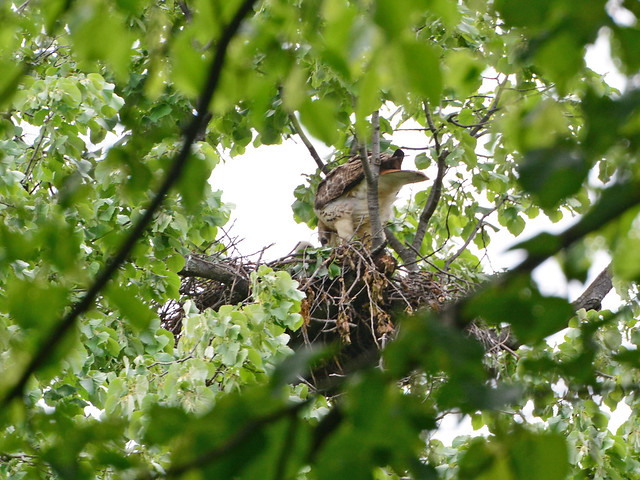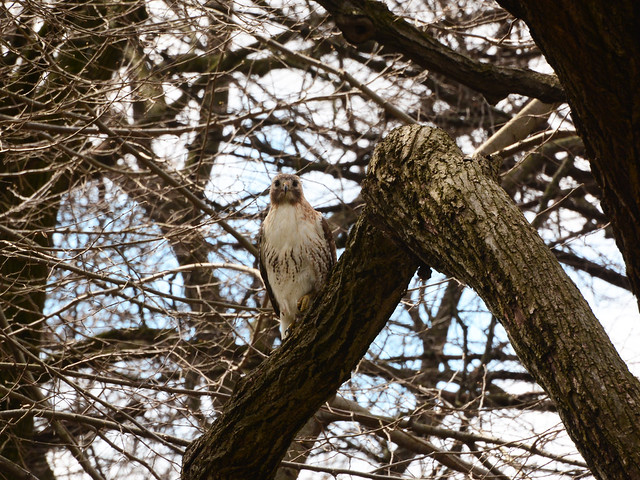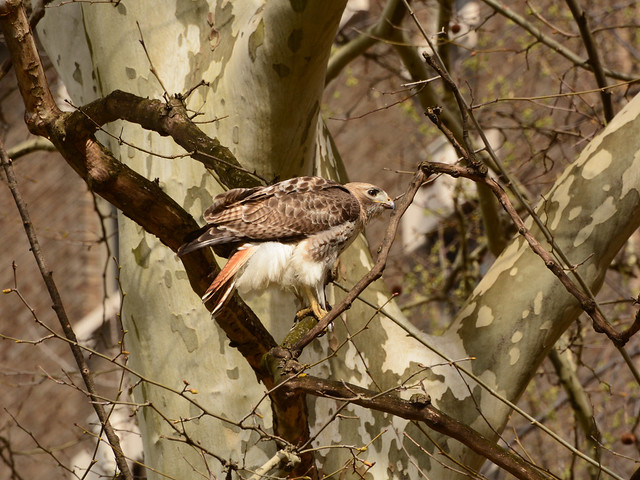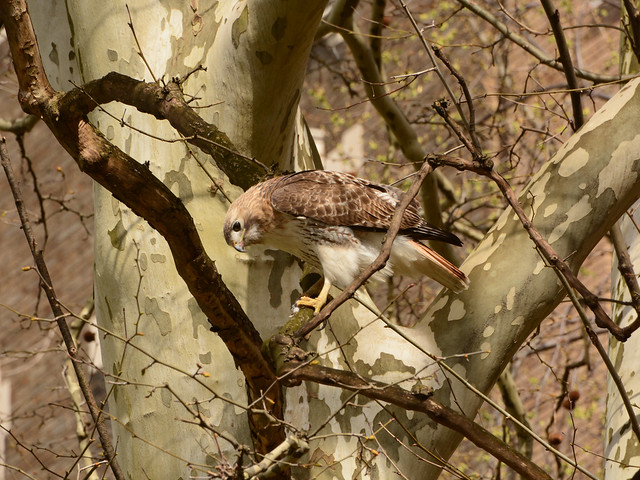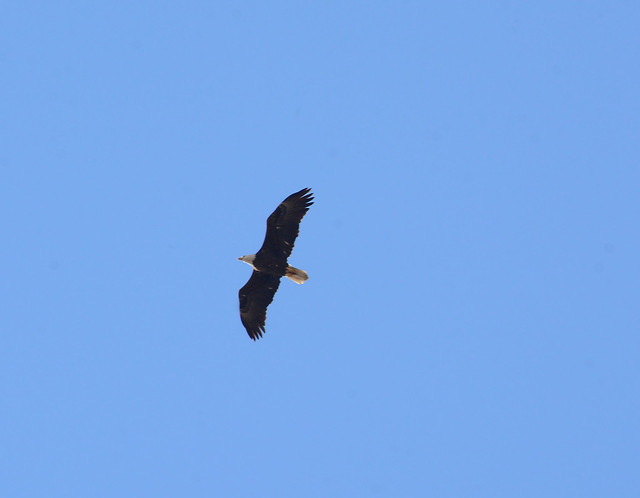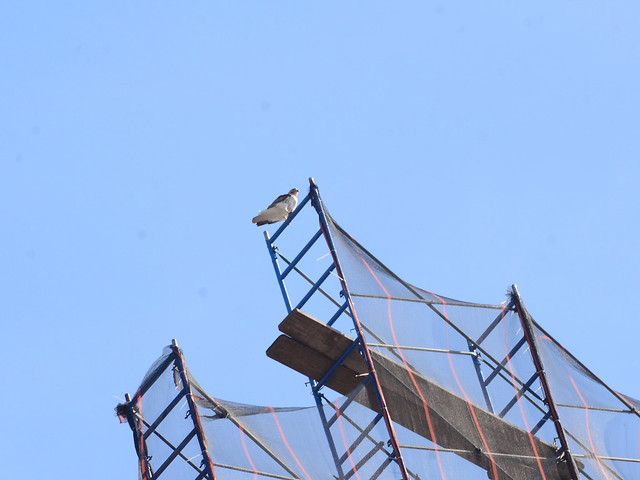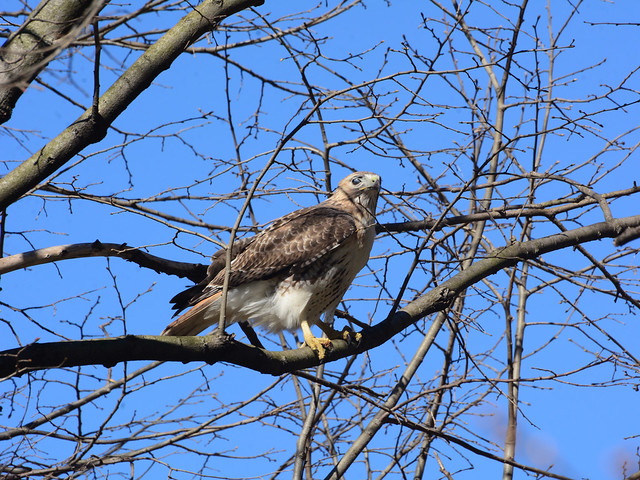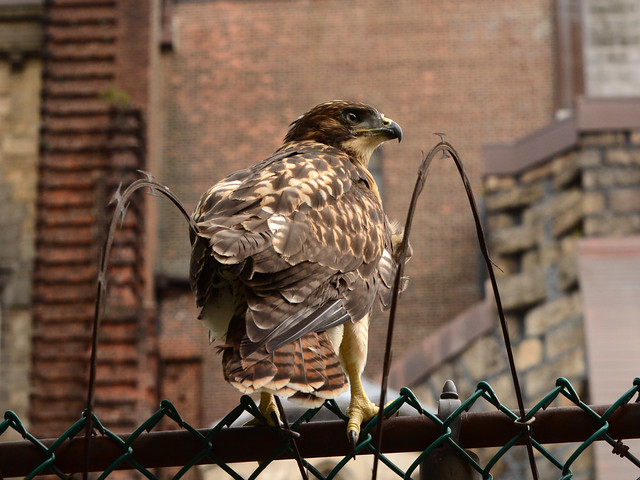(First posted 2012-11-08. Last updated 2023-10-24.)
The table and notes below detail the chronology of the red-tailed hawks who nested at the Cathedral of St. John the Divine from 2006 through 2021.
During this time, the hawks nested in two locations at the east end of the cathedral. During 2006-2014 (but skipping 2009), the nest was in an alcove behind the shoulders of the large statue of St. Andrew on the apse wall. From 2015 through 2021, the nest was in the turret above the nearby large statue of St. Peter. Previously, there was a failed nesting attempt reported "somewhere" at the cathedral in 2000. In 2022, the hawks seem to have "picked up sticks" and moved to a new nest site on the Columbia University campus, where they have now nested for two seasons.
As of the end of the 2021 nesting season, there had been 31 or 32 known hatches at the cathedral nests since 2006, and 28 young hawks had fledged (flown from) the nest. What happened to most of the young birds after they "left home" is unknown and cannot be known. We do know that four or five fledglings suffered injury or sickness soon after leaving the nest and were rescued and taken to wildlife rehabilitation. Two of these rescues had to be euthanized, one was committed to a wildlife sanctuary, and the other one or two were eventually released.
After the nest site shifted from the alcove behind St. Andrew to the turret above St. Peter, successful hatches and fledging of baby hawks plunged. The exposed (to weather) location of the second location seems a likely explanation for some/much of the decline, but there may also been a change in fertility when a new male hawk appeared in 2018.
The adult hawks nesting at the cathedral have not been the same pair over the duration that this history details. There have been at least three females (Isolde, Madeleine, unnamed, ...) and at least three males (Tristan, Norman, Wyatt, ...).
| Year |
Adults |
1st Hatch |
Nestlings |
Fledges |
Notes |
| 2006 |
Isolde & Tristan |
Apr. 27? |
2 (3?) |
June 12
June 16 |
1, 2, 3 |
| 2007 |
Isolde & Tristan |
Apr. 27 |
3 |
June 12 (46d)
June 15
June 15 |
|
| 2008 |
Isolde & Norman |
May 4 |
2 |
June 15 (42d)
June 15 |
4, 5 |
| 2009 |
— |
— |
— |
— |
6 |
| 2010 |
Isolde & Norman |
Apr. 18 |
3 |
June 4 (46d) |
7 |
| 2011 |
Isolde & Norman |
Apr. 26 |
3 |
June 12/13 (47d)
June 12/13
June 16 |
|
| 2012 |
Isolde & Norman |
Apr. 17 |
3 |
June 3 (47d)
June 6
June 8 |
|
| 2013 |
Isolde & Norman (?) |
Apr. 21 |
3 |
June 1/8 (41d/48d)
June 5 (45d)
June 9 |
8, 9 |
| 2014 |
Isolde (?) & Norman |
Apr. 22 |
3 |
June 4 (43d)
June 7
June 9 |
10, 11 |
| 2015 |
Madeleine & Norman |
June 15-20? |
1 |
— |
12, 13, 14 |
| 2016 |
Madeleine & Norman |
Apr. 18 |
3 |
May 27 (39d)
May 30
June 2 |
15, 16 |
| 2017 |
Madeleine & Norman |
May 17 |
3 |
July 2/3 (46d)
July 2/3
July 5 |
17 |
| 2018 |
Madeleine & Wyatt |
— |
— |
— |
18, 19 |
| 2019 |
Madeleine & Wyatt |
May 4 |
2 |
June 19 (46d)
June 19/20 |
20, 21 |
| 2020 |
Madeleine (?) & Wyatt (?) |
— |
— |
— |
22, 23, 24 |
| 2021 |
(?) & Wyatt (?) |
— |
— |
— |
25, 26 |
| 2022 |
(?) & Wyatt (?) |
— |
— |
— |
27 |
| 2023 |
(?) & Wyatt (?) |
— |
— |
— |
28 |
The date given for first hatch is based on the first reported observation of either feeding behavior or other activity by the adult(s) that suggested that there was a baby hawk in the nest. This is likely to be a day or two after actual hatch. In one extreme case (2015), the first clue of the baby hawk's presence may not have been observed until 7-10 days after hatch. It is possible that the first evidence of a nestling in 2016 was also a few days late.
First flight (fledging) of a baby hawk from the cathedral nest was usually about 45 days after first signs of a hatch.
Notes
1
A previous nest on the cathedral was reported in the April 2, 2000, New York Times, but a week later the newspaper reported that the male hawk had died. No further info is known about that nest site except that it was visible from St. Luke's hospital.
2
Stick collecting and possible nest building at the nest site on St. Andrew's shoulders was photographed in 2004. However, a nest by Central Park's North Meadow (approx. 3/4 mile away) was reported to have successfully fledged three babies in 2004. The 2006 cathedral nest may have originated as a "secondary nest" for the Central Park hawks.
3
Regular observations by photographers of the 2006 nest did not begin until mid-May. Two photos posted on the Urban Hawks blog strongly suggest that there were three nestlings. If so, the third was spotted May 27, about four weeks after hatch, but was never seen thereafter.
4
Tristan is presumed to have died Feb. 21, 2008, after suffering a wing injury and becoming grounded the day of a snowstorm. Norman was first observed on Feb. 25.
5
One 2008 fledgling was rescued a few days after leaving the nest and was diagnosed with lead poisoning — possibly due to ingesting material from repair/replacement then occurring on the cathedral apse roof. After a few months at rehabbers, it was deemed unreleasable and was subsequently turned over to a wildlife sanctuary.
6
No nesting activity was seen at the cathedral location in 2009, and other hawks were often seen in the area in late March. Did Isolde and Norman not use the site because of stress from the renovation scaffolding which remained in place until early May? Did they try to nest somewhere else? Both were seen perched atop "Norman's chimney" at St. Luke's hospital on April 19 for over a half hour, suggesting they had no eggs or nestlings to worry about.
7
Two 2010 nestlings died before fledging, one at about three weeks after hatch and the second at about five weeks.
8
A hawk found dead in Central Park's North Woods after Hurricane Sandy (Oct. 29-30, 2012) was thought to have been Norman. However, the 2013 male hawk looked like Norman. It is also possible that the deceased hawk was Isolde (see note 10). Or the deceased hawk may have been a "floater" who was in the area at the time.
9
The first 2013 fledge was very early and was plainly a nestling who fell out of or was bumped from the nest, landing directly below in an alcove between cathedral chapels. It stayed in the alcove for seven days before venturing out. Meanwhile an elder sibling made an actual flight from the nest.
10
A sick adult hawk was rescued from the cathedral grounds on June 4, 2014, and taken to wildlife rehabbers. Despite promising signs, it died of frounce on June 18. Due to the relatively small size of the bird, it was thought to be the male, but a necropsy by state wildlife officials revealed it was a female. As Isolde had not been not considered "small" by hawkwatchers, was this a different female and if so when did she replace Isolde? Or was Isolde the hawk killed in late 2012 by Hurricane Sandy (see note 8)?
11
One fledgling from the 2014 nest was rescued from the cathedral grounds on June 18, 10-14 days after leaving the nest, and found to be suffering from frounce, the same disease that killed its mother. Also, in mid-July a fledgling red-tail was rescued in northern Central Park and found to be underfed and underweight. Odds are that this hungry fledgling was one of the cathedral birds. Both of these fledglings were reported to have recovered and to have been released by rehabbers a few months later.
12
Despite construction of the very nearby apartment building, red-tailed hawks returned to the cathedral in 2015. But likely due to increasingly cramped conditions in the St. Andrew's nest alcove, they shifted to a new nesting site about 30 feet away, in the turret above the statue of St. Peter. Stick collecting in that turret had been observed during spring 2014. It is not known when the new female hawk, Madeleine, arrived except that hospital workers had reported seeing her by mid-February 2015.
13
The 2015 hatch was six to eight weeks late. There was apparently a failure of the first clutch of eggs, which were laid in late March and should have hatched by the first of May. Following a series of matings observed in early May, the female laid a second clutch. Hatch date is estimated. Feeding behavior was first noted June 25, but subsequent observations indicated that the single baby was so large that it must have hatched well in advance of that date.
14
No reports were received that the single 2015 baby hawk fledged the nest, nor was a fledgling ever reported in the area around the cathedral. The nestling was last reported seen on July 24, while an observer on Aug. 1 said the nest was empty and that there was no fledgling hawk in the area. Fledging had been expected roughly Aug. 5, so it is believed that the bird died in the nest at age roughly six weeks.
15
Although the first 2016 fledge appears to have left the nest early, it did not look overly young to have done so. Instead, it seemed rather adventuresome and ambitious. It may have hatched a few days before the first observation of a feeding occurred, and so age-wise was entering the "fledging window".
16
On June 1, 2016, an injured fledgling red-tailed hawk was picked up by NYPD at or near Manhattan Ave. and 109th St., about 3-4 blocks from the cathedral nest. Presumably this was the first fledgling. Although X-rays indicated there were no broken bones, the fledge apparently suffered a spinal injury that paralyzed her legs. She was euthanized a week later as her condition continued to deteriorate.
17
The 2017 first clutch of eggs apparently laid about March 12 failed. Matings were observed early/mid-April and a second clutch laid about April 15.
18
The 2018 male has different throat feather coloring from the male of 2017 and prior years, i.e., his throat feathers were white. It is not known what happened to Norman.
19
Although it appeared in late March 2018 that the female had started brooding a clutch of eggs, in mid-April there were signs that there had been a nest failure. The hawks were observed mating on April 20, suggesting that they were making a second try. But thereafter there was no sign of the female brooding a second clutch of eggs.
20
Although the first sign of hatch in 2019 appears to have been late, it also seems to have been no more than that, just simply late. Other Manhattan nests started reported hatches beginning about April 20.
21
The second 2019 fledgling was found grounded the afternoon of June 20 in the cathedral service area just north of the nest. It had some head trauma and was taken to veterinary care and rehab. Unfortunately, this fledgling also suffered from lead poisoning. Its condition deteriorated while it was at the rehabbers, and eventually it had to be euthanized.
22
An adult male red-tailed hawk was rescued close by in Morningside Park on March 14, 2020, but was reported to have died from injuries the following day. Although this may have been Wyatt, some evidence suggests the hawk may instead have been an interloper in the area.
23
Photos on May 22 and 23, 2020, of what is presumed to have been the female hawk show different throat feather coloring from that of Madeleine.
24
A brooding adult was observed in the nest on April 10, 2020, and as late as May 22. From May 23 on, no observations showed any hawk at the nest. Despite some very slight evidence of a possible hatch about May 10, it seems more likely that there was no hatch at all and the nesting failed.
25
Observations of the adult hawks by this blog during 2021 were so limited that it was impossible to determine whether either was one of the hawks from 2020. However, other observers have indicated their belief that the 2021 (and possibly 2022) male was Wyatt.
26
Brooding of eggs at the nest in 2021 was not observed until April 23, roughly the same week as some other nests in Manhattan reported first hatch. Hatch was thus expected roughly May 23, but observations of the nest on that date saw no hawks of any age in the nest. A third-hand observation from about May 10 suggests that the female may have had an injury and possibly died.
27
The SJD nest was empty of a brooding mother during visits in April and May. It seems probable that the 2021 male and a new female were the birds who instead nested about 0.2 miles away on a balcony on John Jay Hall overlooking the main quad of the Columbia University campus. Two babies fledged from that nest, although at least one of them subsequently died of frounce.
28
Despite early season reports from neighborhood dogwalkers of hawk activity around the cathedral, there was no hawk nesting there. As it turned out, hawks had instead returned to Columbia University, nesting on the clock alcove high on the south side of Havemeyer Hall. They fledged three young birds.


